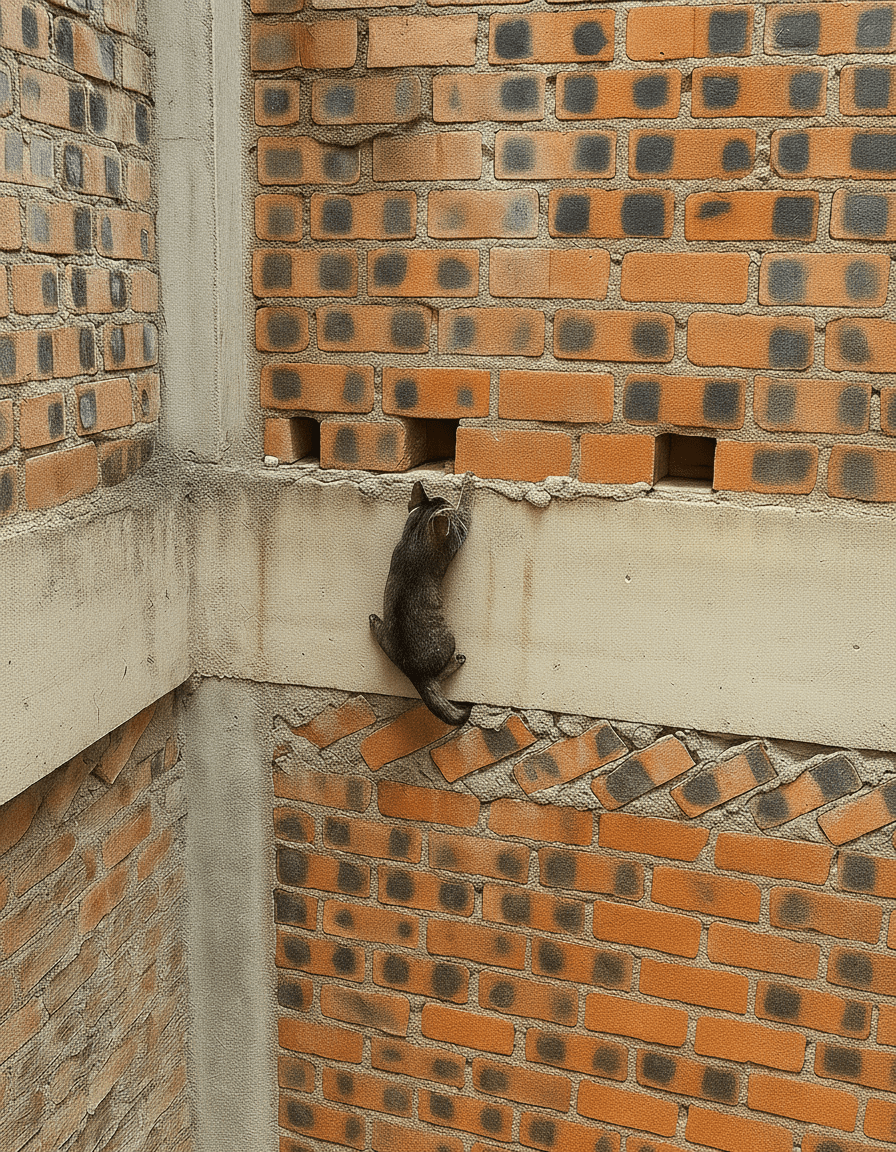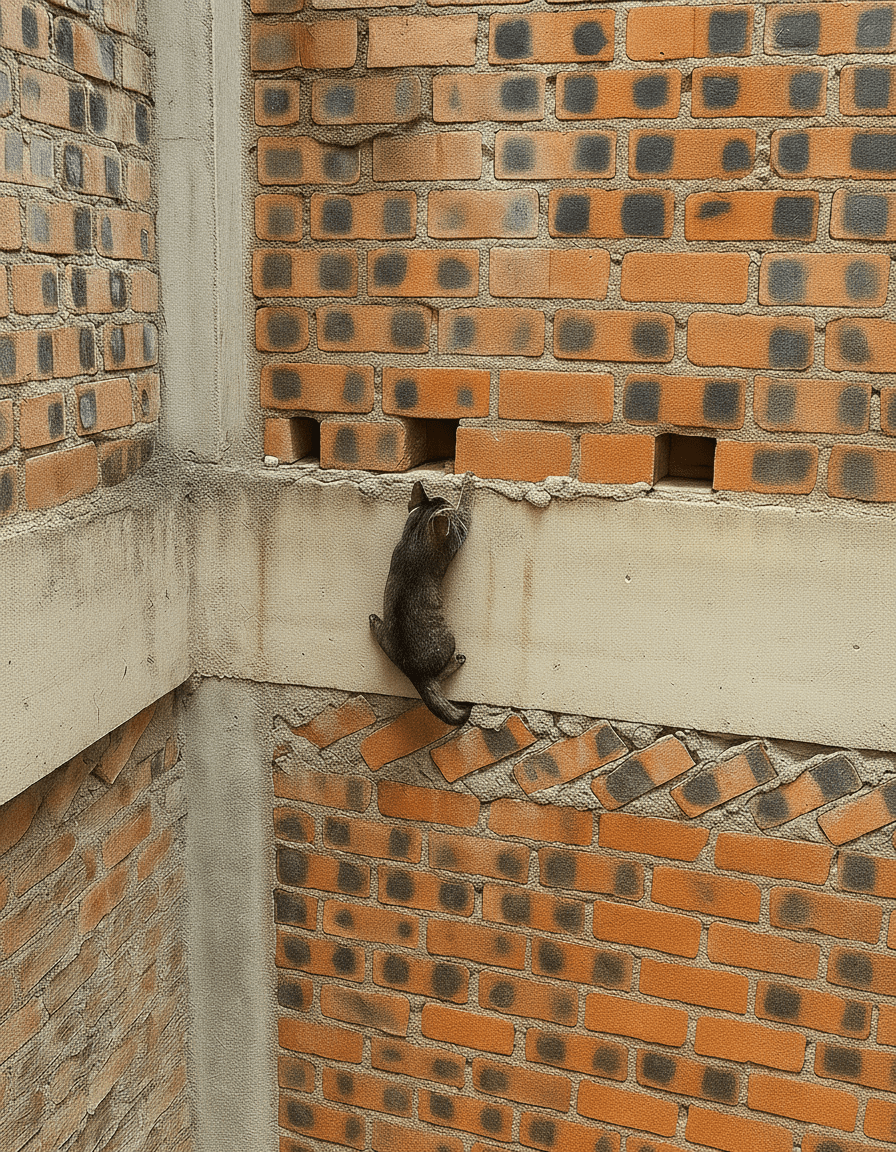In the sweltering heat of a late afternoon in Ho Chi Minh City, a construction site on the outskirts of District 7 became the stage for an unfolding drama that no one could have scripted. Workers had just broken for lunch when a faint, almost imperceptible mewling drifted down from the unfinished third floor of a half-built apartment block. At first, the sound blended with the distant hum of motorbikes and the clatter of scaffolding, dismissed as just another stray cat prowling the beams. But the cries grew sharper, more frantic, until a young bricklayer named Minh glanced upward and froze. There, wedged against a narrow concrete ledge no wider than a paperback book, hung a tiny tabby kitten—barely six weeks old, its fur matted with dust and its hind legs kicking uselessly over a thirty-foot drop to the jagged rebar below. The ledge jutted out from a ventilation shaft, a precarious perch formed by a misaligned brick that had crumbled under the kitten’s weight. One slip, one exhausted tremor, and the void waited hungrily. What followed was a rescue operation riddled with unexpected setbacks, improvised tools, and a finale that left even seasoned rescuers wiping away tears

.
The discovery happened at 2:17 p.m. on a Wednesday that had otherwise been unremarkable. Minh, still clutching his half-eaten bánh mì, shouted for his coworkers. Within minutes, a crowd of hard-hatted men formed a semicircle on the ground, necks craned, phones raised. The kitten—later nicknamed “Còi” for its piercing, whistle-like cries—had somehow scaled the exterior scaffolding during the night, perhaps chasing a moth or fleeing a dog. It had squeezed through a gap in the safety netting, climbed a vertical rebar ladder, and then, in a moment of feline misjudgment, leaped toward what it thought was solid footing. Instead, it landed on the crumbling ledge, its front paws scrabbling for purchase while its body dangled like a furry pendulum. The brick beneath its chest was already fracturing; tiny chips of mortar rained down with every desperate clawing motion.
The first attempt to save Còi was instinctive but doomed. A worker named Tuấn grabbed a bamboo pole from the scaffolding and tried to nudge the kitten toward a nearby window opening. The pole, however, was too rigid. When Tuấn prodded gently, Còi panicked and shifted its weight backward. A collective gasp rose from below as the kitten’s hind paws slipped entirely off the ledge. For three agonizing seconds, it hung by its front claws alone, tail lashing, eyes wide with terror. Tuấn froze, afraid that any further movement would dislodge the fragile grip. The pole hovered uselessly in mid-air.
That was when Mrs. Lan, a street vendor who sold iced coffee to the construction crew, pushed through the crowd. At sixty-two, she was known for her no-nonsense demeanor and a lifetime of rescuing strays from drainage ditches and rooftop gutters. She assessed the situation with a single glance and barked orders in rapid Vietnamese. “Get me the fishnet from my cart! And someone find a cardboard box—soft landing if it falls!” Her voice cut through the chaos like a blade. Within moments, her battered fishnet—usually used to strain coconut milk—was stretched between two workers on the second-floor scaffolding, forming a makeshift trampoline directly beneath the kitten.
But the height was the problem. The second floor was still fifteen feet below Còi, and the net sagged under its own weight. Mrs. Lan realized they needed elevation. She spotted a stack of unused plywood sheets leaning against a pillar. “Stack them! Make a platform!” she commanded. The workers scrambled, sliding the heavy boards into place, but the first stack toppled with a crash that sent dust billowing. Còi, startled by the noise, let out a shriek and shifted again. A chunk of the ledge broke away, tumbling past the net and clattering onto the ground. The kitten’s left front paw slipped. Now it hung by three claws, its body twisting at an impossible angle.
Time fractured into heartbeats. Minh, the bricklayer who had first spotted Còi, volunteered to climb the scaffolding himself. He was the lightest on site, barely 55 kilograms, and had experience balancing on narrow beams. Stripping off his work boots for better grip, he began the ascent. The metal poles were scorching under the sun, and every rung creaked ominously. Halfway up, a sudden gust of wind whipped through the open structure, swaying the entire scaffold. Minh’s foot slipped on a loose bolt. He caught himself on a crossbar, but the jolt sent a cascade of gravel raining down. One pebble struck Còi on the nose. The kitten’s remaining claws scrabbled, and for a horrifying instant, it looked as though the end had come.
Yet Còi did not fall. Whether through sheer will or feline stubbornness, it managed to hook its chin over the edge, redistributing its weight just enough to regain a fourth clawhold. The crowd below exhaled in unison. Minh, sweat streaming into his eyes, resumed climbing. He reached the third-floor platform, only to discover another obstacle: the ventilation shaft blocked direct access to the ledge. The opening was too narrow for an adult arm, and the concrete lip was too high to lean over safely. He needed something long, flexible, and gentle.
That something arrived in the form of a child’s jump rope. A passerby on a motorbike had heard the commotion and screeched to a halt. The rider, a teenage girl named Linh, rummaged in her schoolbag and produced the neon-pink rope. “My little brother uses it for double-dutch,” she explained breathlessly. Minh looped one end into a soft lasso, the kind used for catching stray dogs without harming them. Lying flat on the platform, he inched the rope toward Còi’s scruff. The kitten, exhausted and trembling, eyed the approaching loop with suspicion. Twice, Minh nearly had it around the neck, only for Còi to jerk away at the last second. Each evasion cost precious energy; the kitten’s mewls were growing weaker.

Then came the twist no one expected. From the ventilation shaft behind the ledge, a second kitten—smaller, black-and-white, and even more terrified—poked its head out. It was Còi’s sibling, apparently trapped inside the shaft the entire time. The appearance of the second kitten changed everything. Còi, perhaps sensing family, summoned a burst of strength and tried to crawl toward the shaft. The movement dislodged more mortar. A fissure snaked across the ledge. With a sickening crack, the entire brick gave way.
Còi fell.
The net was still five feet too low. Mrs. Lan screamed. Minh lunged forward, arm extended over the edge, fingers brushing fur. But it was Linh, the teenage girl, who made the impossible catch. She had climbed the plywood stack barefoot, balancing precariously, and at the exact moment Còi plummeted, she thrust the jump rope upward like a fishing line. The lasso caught not Còi’s neck but its front paw, yanking the kitten sideways into Minh’s waiting grasp. The impact sent Minh sprawling backward onto the platform, Còi clutched against his chest. Below, the black-and-white sibling, spooked by the collapse, bolted deeper into the shaft and vanished.
Silence blanketed the site. Then cheers erupted—raw, ragged, and relieved. Minh descended the scaffolding with Còi wrapped in his T-shirt, the kitten’s heart hammering against his own. Mrs. Lan was already preparing a saucer of condensed milk diluted with water. Linh, tears streaking her dusty cheeks, refused to let go of the jump rope, now frayed and precious. The workers passed around cigarettes with shaking hands, recounting the near-misses in hushed, reverent tones.
But the story wasn’t over. The second kitten remained trapped inside the ventilation shaft, its cries echoing faintly. Nightfall was approaching, and the site would be locked. A quick conference decided on one final push. Using flashlights and a flexible plumbing snake borrowed from a nearby hardware store, Tuấn and Minh threaded the tool into the shaft. After twenty tense minutes, the snake’s hook snagged a tiny collar—actually a piece of red string tied by some child. They pulled gently, inch by inch, until the black-and-white kitten emerged, blinking in the beam of a headlamp. It was dehydrated but unharmed, and the moment it saw Còi, it let out a pitiful mew and stumbled into its sibling’s side.
The reunion was captured on dozens of phones. By the time the site foreman arrived to shut down operations for the day, the videos were already spreading across local Facebook groups. Mrs. Lan declared both kittens adopted on the spot—“They’ve earned their keep with all this drama,” she joked—and carried them home in a cardboard box lined with her scarf. Linh insisted on visiting every weekend to check on them, jump rope in hand.
In the end, what began as a routine lunch break became a testament to human ingenuity under pressure. A crumbling ledge, a fishnet, a child’s toy, and the stubborn courage of a six-week-old kitten converged in a rescue that defied every odd. Còi and its sibling—now named Đen for its dark patches—sleep curled together in Mrs. Lan’s courtyard, oblivious to the thirty-foot void they once faced. And every afternoon, when the construction crew breaks for iced coffee, they pause to watch the kittens chase dust motes in the sunlight, a living reminder that sometimes the smallest lives demand the grandest efforts.






